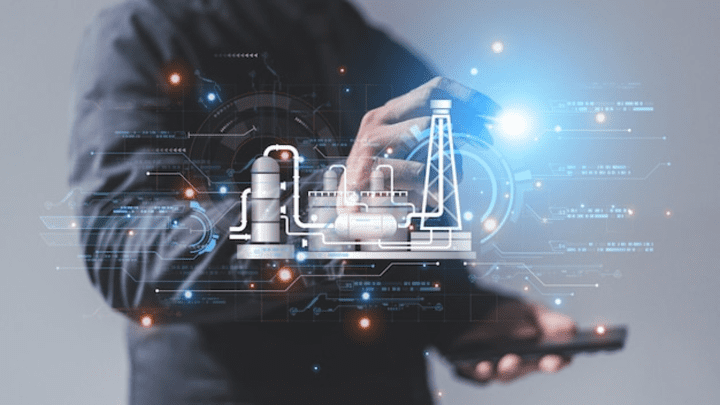6 Ways to improve your oil and gas asset management with operational digital twins
Table of Contents
The Oil & Gas industry is currently facing significant market challenges that are putting traditional business models to the test. Factors such as changing market dynamics, a shortage of skilled professionals, and the imperative to embrace sustainability are disrupting standard practices.
In response, oil & gas companies are under pressure to enhance production and revenue, minimize risks and operational expenses, and innovate their working methods. To navigate these challenges successfully, many companies are turning to technological solutions like digital twins, a form of operational digital twin technology (Operational DTT).
What are Digital Twins?
Digital twins are virtual models of physical assets, enabling organizations to gather and analyze critical data about their assets. This process generates valuable insights, allowing for rapid learning and operational improvements.
However, the advantages of digital twins extend beyond mere operational enhancements. When implemented across the entire enterprise, they empower oil & gas companies to revolutionize traditional working models, laying the groundwork for sustained profitability and growth.
The Future of Digital Twins in Oil and Gas
The oil and gas industry, a pioneer in technological adoption, is on the cusp of a digital revolution, led by the integration of digital twins. These sophisticated virtual models of physical assets are set to transform the sector in several ways, offering a glimpse into the future of oil and gas asset management.
Benefits of Implementing Operational Digital Twins
Predictive Maintenance: Get early warnings for equipment issues, reducing unexpected shutdowns and saving on costly repairs.
Process Optimization: Enhance operational efficiency, maximize resource use, and streamline processes for better productivity.
Monitoring in Real-Time: Continuously watch equipment, detecting problems early to prevent major failures and ensure smooth operations.
Simulating Emergency Situations: Prepare for emergencies with realistic drills, ensuring quick, effective responses in actual crisis situations.
Reducing Waste: Optimize resource usage, minimize waste, and promote sustainable practices in oil and gas operations.
Environmental Stewardship: Monitor and manage environmental impact, balancing industrial activities with ecological responsibility and sustainability.
Common Challenges in Building Operational Digital Twins
While the integration of operational digital twins offers transformative potential for the oil & gas industry, navigating the path to successful implementation can present several challenges. Understanding these hurdles is crucial for companies aiming to leverage this technology effectively.
Data Integration and Real-Time Processing: Integrating disparate data sources and ensuring real-time processing and analysis can be complex, requiring robust data architecture and processing capabilities.
Compatibility with Existing Systems: Ensuring that the digital twin solution seamlessly integrates with existing IT and OT systems is vital for smooth operations and data consistency.
Investment and Cost Analysis: Assessing the initial investment, ongoing costs, and potential ROI is crucial for justifying the implementation of digital twin technology.
Assessing Company Needs and ROI: Each company has unique needs and challenges. Tailoring the digital twin solution to meet these specific requirements and deliver measurable ROI is essential.
Establishing the Right Partnerships: Collaborating with the right technology partners can significantly influence the success of the digital twin project, from initial design to full-scale implementation.
Pilot Projects and Full-Scale Implementation: Starting with pilot projects can help in understanding the practical challenges and benefits before scaling the solution across the organization.
Continuous Monitoring and Updates: Digital twins require ongoing maintenance and updates to reflect changes in the physical assets and operational conditions accurately.
By addressing these challenges head-on, companies can pave the way for a successful digital twin implementation, unlocking new levels of efficiency, safety, and sustainability in their operations.
6 Ways to Improve Your Oil and Gas Asset Management with Operational Digital Twins
1. Enhancing Predictive Maintenance:
Traditional maintenance strategies often rely on scheduled checks, regardless of an asset's actual condition. Predictive maintenance, however, uses data-driven insights to anticipate and address potential issues before they escalate. Digital twins enable continuous monitoring of equipment, analyzing data from sensors to predict wear and tear. This approach not only prevents equipment failures but also optimizes maintenance schedules, saving time and resources.
2. Optimizing Asset Performance:
Key performance indicators (KPIs) like uptime, efficiency, and production rates are critical in asset management. Digital twins help track these metrics in real-time. By continuously analyzing data, digital twins provide insights into performance trends, enabling operators to make adjustments for optimal asset utilization. Leveraging AI algorithms, digital twins can suggest real-time adjustments to operations, enhancing overall asset productivity.
3: Improving Safety and Compliance:
The industry faces inherent risks, from equipment failures to environmental hazards. Ensuring the safety of personnel and compliance with regulations is paramount. Digital twins help monitor safety parameters, ensuring that operations stay within regulatory limits and quickly identifying potential safety breaches.
4: Streamlining Operations and Reducing Downtime:
Digital twins can identify patterns and anomalies that may indicate risks, allowing for preemptive action. By providing a holistic view of operations, digital twins enable more efficient resource allocation and process optimization. Real-time monitoring and predictive analytics significantly reduce unplanned downtime, keeping operations running smoothly.
5: Facilitating Better Decision Making:
With access to real-time data and analytics, decision-makers can base their strategies on solid, up-to-date information. Digital twins can feed into broader decision support systems, providing a comprehensive basis for strategic planning. The insights gained from digital twins inform long-term strategies, from investment decisions to operational changes.
6: Advancing Sustainability and Environmental Goals:
The oil and gas sector is under increasing pressure to reduce its environmental footprint. Digital twins can track environmental impact metrics, helping companies to meet sustainability goals and regulatory requirements.
Case Study: Operational Digital twins in Oil and Gas
Precision Drilling's collaboration with Prescient to implement an operational digital twin solution marks a significant advancement in asset management within the oil and gas industry. This innovative approach, leveraging real-time data from sources like Electronic Drilling Recorder (EDR) and predictive maintenance sensors, has revolutionized equipment performance monitoring.
Prescient’s predictive maintenance capabilities notably reduced unplanned downtime and extended asset lifespan, while enhancing decision-making and workforce efficiency. Russell Whitney, IIoT Manager at Precision Drilling, praised the project's unprecedented level of innovation.
Click here to find out more about Russell Whitney’s comment.
Conclusion
Operational digital twins are revolutionizing asset management in the oil and gas industry. They offer a way to navigate the complexities of modern operations, ensuring efficiency, safety, and sustainability.
As the industry continues to evolve, these technologies will play a pivotal role in shaping its future. For those looking to stay ahead in this dynamic field, embracing operational digital twins is not just an option; it's a necessity. Join the revolution and explore how operational digital twins can transform your asset management strategy here.


